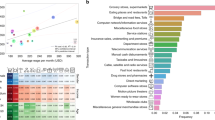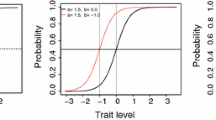Abstract
Recent technological advances have enabled the easy collection of consumer behavior data in real time. Typically, these data contain the time at which a consumer engages in a particular activity such as entering a store, buying a product, or making a call. The occurrence time of certain events must be analyzed as circular random variables, with 24:00 corresponding to 0:00. To effectively implement a marketing strategy (pricing, promotion, or product design), consumers should be segmented into homogeneous groups. This paper proposes a methodology based on circular statistical models from which we construct a clustering algorithm based on the use patterns of consumers. In particular, we model temporal patterns as circular distributions based on nonnegative trigonometric sums (NNTSs). Consumers are clustered into homogeneous groups based on their vectors of parameter estimates by using a spherical k-means clustering algorithm. For this purpose, we define the parameter space of NNTS models as a hypersphere. The methodology is applied to three real datasets comprising the times at which individuals send short-service messages and start voice calls and the check-in times of the users of a mobile application Foursquare.





Similar content being viewed by others
References
Banerjee, A., Dhillon, I.S., Ghosh, J., Sra, S. (2005). Clustering on the unit hypersphere using von mises-fisher distributions. Journal of Machine Learning Research, 6, 1345–82.
Batagelj, V. (1988). Generalized ward and related clustering problems. In Batagelj, V. (Ed.) Classification and related methods of data analysis. North-Holland, Amsterdam (pp. 67–74).
Eagle, N., Pentland, A., Lazer, D. (2009). Inferring social network structure using mobile phone data. Proceedings of the National Academy of Sciences (PNAS), 106-36, 15274–78.
Fernández-Durán, J.J. (2004). Circular distributions based on nonnegative trigonometric sums. Biometrics, 60, 499–503.
Fernández-Durán, J.J., & Gregorio-Domínguez, M.M. (2010). Maximum likelihood estimation of nonnegative trigonometric sums models using a newton-like algorithm on manifolds. Electronic Journal of Statistics, 4, 1402–10.
Fernández-Durán, J.J., & Gregorio-Domínguez, M.M. (2012). CircNNTSR: an R package for the statistical analysis of circular data using nonnegative trigonometric sums (NNTS) models. R package version, 2, 0. http://CRAN.R-project.org/package=CircNNTSR.
Fernández-Durán, J.J., & Gregorio-Domínguez, M.M. (2016). CircNNTSR: an R package for the statistical analysis of circular, multivariate circular, and spherical data using nonnegative trigonometric sums. Journal of Statistical Software, 70–6.
Fisher, N.I. (1993). Statistical analysis of circular data. New York: Cambridge University Press.
Hornik, K. (2005). A CLUE for CLUster Ensembles. Journal of Statistical Software, 14-12, 1–25.
Hornik, J., & Miniero, G. (2009). Synchrony effects on customers’ responses and behaviors. International Journal of Research in Marketing, 26, 34–40.
Hornik, K., Feinerer, I., Kober, M., Buchta, C. (2012). Spherical k-means clustering. Journal of Statistical Software, 50–10.
Hubert, L.J., & Levin, J.R. (1976). A general statistical framework for assessing categorical clustering in free recall. Psychological Bulletin, 83-6, 1072–1080.
Jammalamadaka, S.R., & SenGupta, A. (2001). Topics in circular statistics. River Edge: World Scientific Publishing, Co.
Liao, T.W. (2005). Clustering of time series data : a survey. Pattern Recognition, 38-11, 1857–1874.
MacQueen, J. (1967). Some methods for classification and analysis of multivariate observations. Proceedings of the Fifth Berkeley Symposium on Mathematical Statistics and Probability, 1, 281–297.
Mardia, K.V., & Jupp, P.E. (2000). Directional statistics. New York: John Wiley and Sons.
Milligan, G.W. (1980). An examination of the effect of six types of error perturbation on fifteen clustering algorithms. Psychometrika, 45-3, 325–342.
Montero, P., & Vilar, J.A. (2014). TSClust: an R package for time series clustering. Journal of Statistical Software, 62–1.
R Core Team. (2019). R: a language and environment for statistical computing. R Foundation for Statistical Computing, Vienna, Austria. https://www.R-project.org/.
Rousseeuw, P.J. (1987). Silhouettes: a graphical aid to the interpretation and validation of cluster analysis. Journal of Computational and Applied Mathematics, 20, 53–65.
Steinley, D., & Brusco, M.J. (2007). Initializing K-means batch clustering: a critical evaluation of several techniques. Journal of Classification, 24, 99–121.
Studer, M., Ritschard, G., Gabadinho, A., Müller, N.S. (2011). Discrepancy analysis of state sequences. Sociological Methods and Research, 40-3, 471–510.
Studer, M. (2013). Weightedcluster library manual: a practical guide to creating typologies of trajectories in the social sciences with R. LIVES Working Papers, 24. https://doi.org/10.12682/lives.2296-1658.2013.24.
Upton, G.J.G., & Fingleton, B. (1989). Spatial data analysis by example vol. 2 (categorical and directional data). New York: John Wiley and Sons.
Wedel, M., & Kamakura, W.A. (2000). Market segmentation conceptual and methodological foundations, 2nd edn. Norwell: Kluwer Academic Publishers.
Yang, D., Zhang, D., Chen, L., Qu, B. (2015). NationTelescope: monitoring and visualizing large-scale collective behavior in LBSNs. Journal of Network and Computer Applications, 55, 170–180.
Yang, D., Zhang, D., Qu, B. (2016). Participatory cultural mapping based on collective behavior data in Location-Based social networks. ACM Trans. on Intelligent Systems and Technology (TIST), 7, 1–23.
Yu, Y., & Lambert, D. (1999). Fitting trees to functional data with an application to time-of-day patterns. Journal of Computational and Graphical Statistics, 8(4), 749–762.
Zhong, S. (2005). Efficient online spherical k-means clustering. In Proceedings IEEE, International Joint Conference in Neural Networks (IJCNN 2005), Montreal, Canada, July 31 - August 4, 2005, pp. 3180–85.
Acknowledgments
The authors wish to thank the Asociación Mexicana de Cultura A.C. for its support.
Author information
Authors and Affiliations
Corresponding author
Additional information
Publisher’s Note
Springer Nature remains neutral with regard to jurisdictional claims in published maps and institutional affiliations.
Rights and permissions
About this article
Cite this article
Fernández-Durán, J.J., Gregorio-Domínguez, M.M. Consumer Segmentation Based on Use Patterns. J Classif 38, 72–88 (2021). https://doi.org/10.1007/s00357-019-09360-2
Published:
Issue Date:
DOI: https://doi.org/10.1007/s00357-019-09360-2




